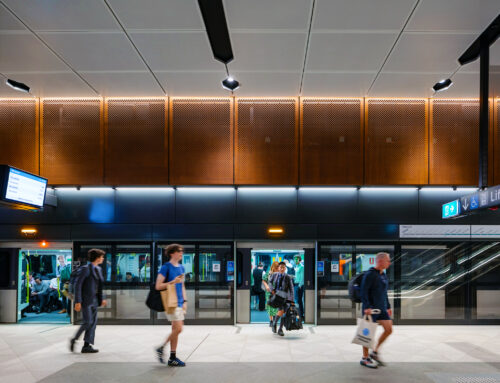In this article, our aviation directors from across Tetra Tech come together to share their insights on how terminal design is more complex, and critical, than it’s ever been.
Airports are deeply complex operational facilities with simplicity as their goal. From fire safety to access paths, our job is to design systems that perform predictably while being easy to understand and maintain.
Designing with the end in mind
Matthew Preston
Associate Director, NDY
Airports take a decade to build and technology evolves much faster than that. It’s critical to plan for change, leaving room for new equipment so infrastructure can adapt as needs change. Whether it’s switchgear size or cooling loads, it’s imperative to design a future-ready facility.
Master planning plays a vital role here. We work closely with clients to design for population growth which can increase passenger flow and lead to additional buildings like hotels or car parks.
Infrastructure is often designed modularly so it can meet the needs of more people, particularly for cooling, power and distribution. This allows the addition of future systems without major redesigns.
Some equipment is sized with allowance for expansion, for example central cooling plants and switchgear rooms.
Services like high voltage rings and pedestrian flows are factored into long-term planning, even if the associated developments won’t be built for another decade.
Operational continuity in live environments
Airports are live 24/7 operations. Upgrades and expansions must happen without disrupting passenger flow and operations. Each gate and terminal represents revenue, whether from flights, retail or services. Delays and disruptions can trigger major losses.
Project teams must plan well and work flexibly – sometimes sprinting across terminals with equipment to catch a gap between flights for testing – all without interfering with the airport’s schedule. That flexibility becomes the mindset of an aviation engineer.
Stakeholder complexity
Angela Templin
Vice President, Government Sector Lead, Glumac
Each airport project involves layers of stakeholders including airport authorities, airline operators, retail tenants and security teams. Coordination is key as each of these groups impacts project success.
Techniques like ‘the big room’ – where all groups come together weekly – helps manage the impact of security access and badging delays. Without careful management, these glitches can easily become project pinch points.
Airport culture
Aviation projects speak their own language. Acronyms like PCA and 400 Hz aren’t just jargon, they represent systems unique to airports. Showing fluency builds confidence and speeds up approvals.
Teams with experience in live airport environments understand not just the systems but the language, culture and urgency that comes with them.
Legacy systems, upgrades and system integration
Scott Ceasar
Vice President, Cosentini Associates
Many airports struggle with outdated as-builts and poor records. Teams often need to physically verify conditions to avoid costly surprises mid-construction. Hazardous materials like asbestos further complicate upgrades.
Systems such as smoke control, ventilation and security are tightly interlinked across terminals. Mistakes or oversights in one area can shut down another.
Smoke control systems have evolved dramatically over time, moving from brute-force air handling to performance-based design supported by computational fluid dynamics (CFD). Collaboration between mechanical and fire engineers is now essential. In many projects, we engineer solutions together, sitting side by side.
Legacy systems also introduce challenges like undocumented cabling, often with hundreds of unidentified cables jammed together. Modernisation isn’t just about installation; it’s also about untangling the past and making systems work together safely under current code.
Supply chain and resourcing
Airports rely on niche systems, sometimes serviced by just a few global specialists. For example, there are only a handful of engineers qualified to commission PCA systems or 400 Hz generators. These providers must be scheduled well in advance and teams must flex around their availability.
Some equipment, like switchgear or air handling units (AHUs), has lead times as long as 90 weeks. Design decisions must be locked in early even when the rest of the project is still evolving. To manage this, equipment is often slightly oversized and designed with flexibility in mind.
While heating, ventilation and air-conditioning (HVAC) components are now available faster due to modern manufacturing, strategic planning and sequencing are still key to keeping projects moving.
Resilience and sustainability
Resilient power, including generators or battery storage, is essential.
Power supply in airports often includes dual feeds and stand-by transformers. HVAC plants are designed to operate bi-directionally so if one pipe fails, another can take over.
Levels of resilience are tailored based on operational priority. Premium carriers demand more robust systems to avoid delays while lower-cost carriers may accept slightly lower thresholds.
But, resilience isn’t just about backup systems; it’s also about ensuring fire alarms don’t trigger unnecessary terminal evacuations that can cost millions. Airports need robust yet adaptable designs that allow for modernisation without system-wide disruption.
Retail centres with runways
An airport’s role as an economic hub means every square metre must work hard, offering both an optimal passenger experience while delivering meaningful commercial return. With increased competition between airports, these drivers are more important than ever.
Future design must accommodate changes in technology, travel behaviour and expectations while remaining flexible for tenants and operators.
Electric vehicles in airports
Electric vehicle (EV) infrastructure is becoming an integral part of both landside and airside. As electrification takes over aircraft, service vehicles and passenger transport, planning for future grid demands and charging stations is key.
These infrastructure challenges tie tightly to sustainability goals and fire safety considerations.
Human hubs, not operational hubs
At their core, airports serve people. This means safety and seamless experiences. Terminals that are easier to navigate, better connected and more comfortable give airports the edge.
As aviation engineers, it’s important we don’t simply design assets. We need to design human systems that work today and are capable of scale and adaptation.
Why experience matters
At the heart of world-leading airport design is experience. The complexity of systems and technology needs a comprehensive understanding of the people who use, maintain and benefit from them as well as robust knowledge of legacy equipment and the industry’s culture.
Aviation projects are unique in their constraints, stakeholders and risk. Experience matters, especially when integrating old and new systems or navigating the often conflicting demands of stakeholder groups.
An ability to draw on global specialists who have worked on airports around the world and delivered design-firsts puts engineering teams at an advantage. This knowledge transfer across projects and geographies provides deep insight and expediates design.










